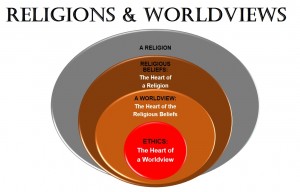The Christian Worldview – Part 1: Worldviews
1.Christianity is a religion (NOT a relationship with Jesus).
- The word “Christianity” is defined in dictionaries as being a religion.
- Sociologists, Philosophers of Religion, and Religious Studies scholars consider Christianity to be a religion.
- A religion is something that could be true or that could be false, but a relationship cannot be true and cannot be false.
- All, or virtually all, Christian apologists claim that “Christianity is true.”
2. Religions have several dimensions.
Ninian Smart is a widely respected expert in comparative religions. He asserts that religions are complex historical phenomena that have several dimensions, particularly the following six dimensions:
1.Doctrinal and Philosophical
2.Mythic and Narrative
3.Ethical or Legal
4.Ritual or Practical
5.Experiential or Emotional
6.Social or Institutional
(Worldviews, 3rd edition, pages: 8-10)
3. The Most basic and important dimension of a religion is the doctrinal and philosphical dimension (i.e. religious beliefs).
- It is the religious beliefs associated with a religion that makes it possible for a religion to be true or to be false.
- We can identify a religious experience, or a religious ritual, or a religious story ONLY IF we can identify religious beliefs.
- We can identify a religious experience only if we can determine that an experience has a religious meaning.
- We can identify a religious ritual only if we can determine that a ritual has a religious meaning.
- We can identify a religious narrative (story) only if we can determine that a narrative (story) has a religious meaning.
- We can determine that an experience, ritual, or story has a religious meaning, only if we can identify religious beliefs.
- Error Theory: Religious Studies scholars tend to view religious experience as the most basic and important dimension of a religion. I believe that they have this view because religious experience provides a plausible causal theory of religion. Smart argues that numinous religious experiences provide an explanation for religious beliefs, such as belief in the existence of God, as understood in Western religions, and that mystical religious experiences provide an explanation for religious beliefs, such as the pantheistic view of some Eastern religions, where it is thought that the ultimate reality is a single being which is impersonal. Religious Studies is basically historical and anthropological, and in both history and anthropology, causal theories are of great importance. Even if religious experience does provide the basis for the best causal theories about religions, it does not follow that the concept of religious experiences is logically or conceptually more basic than the concept of religious beliefs.
4. The most basic and important religious beliefs associated with a religion are the religious beliefs that constitute the worldview associated with that religion.
- A worldview can be thought of as a philosophy of life, which consists of basic beliefs in the following areas of philosophy:
- ETHICS: How should we live our lives? What constitutes a good human life? What are the most basic and important goals of human life?
- METAPHYSICS: What kinds of things exist? What is the basic nature and structure of reality?
- EPISTEMOLOGY: What can we know? How can we know what we know? How can we determine which beliefs are true and rationally justified or warranted?
- A worldview can also be thought of as a very general problem-solving scheme, which provides answers to these important questions:
- What are the most basic and important goals for a human life?
- What are the most basic and important problems that can prevent a person from acheiving those goals?
- What are the most basic and important opportunities that can help a person to acheive those goals?
- What are the best ways to resolve or mitigate those basic and important problems?
- What are the best ways to utilize those basic and important opportunities?
- What are the best ways to acheive the most basic and important goals of a human life?
NOTE: I am using the word “worldview” in a much narrower sense than Ninian Smart. According to Smart, worldviews involve the six dimensions listed above. I, however, take it that a “worldview” is the core of the doctrinal/philosophical beliefs of a religion (or of a secular analogue to a religion).
5. The heart of a worldview (whether religious or secular) is ETHICS.
- If we think of a worldview as a very general problem-solving scheme, then it is obvious that ETHICS is the heart of a worldview.
- On the other hand, if we think of a worldview as a philosophy of life, which includes ETHICS, METAPHYSICS, and EPISTEMOLOGY, it still makes sense to see ETHICS as the heart of a worldview.
- The most pressing and obvious philosophical issues for humans are ethical: How should I live my life? What constitutes a good life? What are the most basic and important goals of a human life?
- As soon as someone puts forward an ethical point of view, questions and challenges will arise about whether that view is correct or the best view, and this will lead those who agree with that viewpoint to put forward reasons in support of the correctness or worthiness of that point of view.
- When one puts forward reasons in support of the correctness or worthiness of an ethical viewpoint, that involves making assertions or assumptions in METAPHYSICS and EPISTEMOLOGY.
- ETHICS is thus the natural starting point of philosophy, and METAPHYSICS and EPISTEMOLOGY are thus natural developments that arise out of attempts to rationally justify an ethical point of view.
Click on the image below for a clearer view of the diagram:




